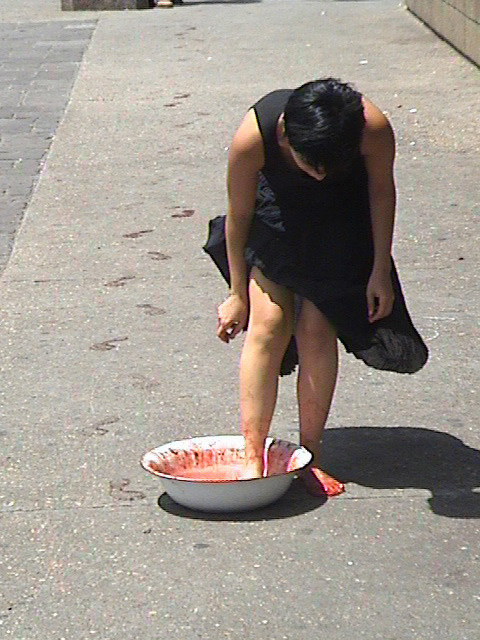26/1/2012
Regina Jose' Galindo
Artium, Vitoria-Gasteiz
Goose bumps are a human response to external stimuli such as cold or emotion and are caused by the contraction of the 'musculus erector pili', curiously known in Spanish as the terrifying or hair-raising muscle. When the muscle contracts, the hair stands upright. The title of the exhibition, Goose Flesh, refers directly to the emotion stirred by the artist's pieces but also to the flesh, to the material and human nature of her work. The show is a journey taken by the word through the body, a journey that makes its way through five rooms, triggering the spectator's musculus erector pili as it advances.

curated by Blanca de la Torre
Regina José Galindo (1974, Guatemala City) began her artistic evolution as a poet. It was in 1999 that she started to use her body as part of her work in a more direct manner by adopting performance as her chief medium of expression. Her work leads us into the problems of current society, into a stark reality, through the discourse of her own body and by means of a series of actions that are equally stark, unrestrained and full of symbolism and which lead the artist to place herself in extreme situations that are also intense points of reflection for spectators.
Her actions stir the observer powerfully and have an undeniable impact. At the same time, however, they act as personal rituals, as an elegy, as succinct expressions of tribute to a collective that is the victim of a social reality, of abuse, of injustice. As she herself puts it, Regina uses her body so that it can be a reflection of other bodies.
Goose bumps are a human response to external stimuli such as cold or emotion and are caused by the contraction of the musculus erector pili, curiously known in Spanish as the terrifying or hair-raising muscle. When the muscle contracts, the hair stands upright. The title of the exhibition, Goose Flesh, refers directly to the emotion stirred by the artist’s pieces but also to the flesh, to the material and human nature of her work.
Goose Flesh is a journey taken by the word through the body, a journey that makes its way through five rooms, triggering the spectator’s musculus erector pili as it advances.
The first of these rooms features a style of speaking, a concept of discourse in which the word comes to the fore as the protagonist of the work, beginning with Lo voy a gritar al viento (1999; I’m Going to Shout It to the Wind), in which the artist hung herself from a bridge in Guatemala City to shout her poems in public.
From here we move on to a space dominated by metaphor in which we see the more poetic side of Regina in a series of works in which the artist’s body splits into a kind of alter ego and puts itself into the skin of the altered other, the sufferer, the other subjected to injustice. In this section, concepts key to the realm of performance as melancholy begin to come into play: the association between identity, melancholy, repetition and performance.
As we make our way into the next room, we come to the more fleshly, or rather, the more stark Regina in a series of pieces in which the physicality of torture gives us insights into the trauma of one’s own death, associated with the death of others.
The central space speaks to us of overcoming past traumas through a fictitious reconstruction based on the Venice Biennale. Galindo has been selected on four occasions to show her work at this event and in 2005 won the prestigious Golden Lion. A reproduction of this award, made after the show, stands in the centre and structures the room as a whole, raising a host of questions entailed by the very fact of participating in the Biennale, the sweeping change that occurs in an artist’s career once she has participated in an event of this nature, and the range of contradictions this implies.
Lastly, the final room focuses on the concept of ‘transmission’ by depositing part of the action on the ‘other’, that ‘other’ as an active agent, either as the vehicle onto which the action directly devolves or as another person in the plot—plot here being understand as the artistic action—or as an agent without whom the action would remain totally neutralised.
This room also provides the frame for the artist’s performance from which the exhibition takes its title, Goose Flesh, during which Regina will remain for the duration of the show’s opening inside a mortuary refrigerator. Spectators will be able to open the chamber at any time and see the transformation of her skin caused by the cold. This action will be recorded and subsequently shown as a piece in the exhibition.
Produced by ARTIUM (Vitoria-Gasteiz), TEA (Santa Cruz de Tenerife) and CAAM (Las Palmas de Gran Canaria).
Catalogue of the exhibition by ARTIUM. Texts by Maite Garbayo, Omar Pascual and Sayuri Guzmán.
Image: Quien Puede Borrar Las Huellas (Who Can Remove the Traces) (2003). Single-channel digital video, 1:52 minutes. Courtesy of the artist
Opening: January 27, Friday, 8.00 pm.
Performance by Regina José Galindo (Goose Flesh): January 27, friday, 8.00pm.
Conversation between Regina José Galindo and Blanca de la Torre: January 28, Saturday, 12.30pm.
Artium - North Gallery
Calle Francia 24 - Vitoria-Gasteiz
Hours:
From Tuesday to Friday: 11.00 - 14.00 and 17.00 - 20.00
Saturdays and Sundays: 11.00 - 21.00
Mondays: closed (unless this coincides with a public holiday)
The ticket office will remain open until half an hour before closing time.
Admission:
General ticket: 6 €
Annual ticket: 10 €
Guided visits (group): 73,00 €, individual ticket included. Max. 25 people by group



